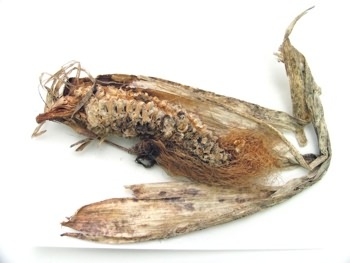Diseases
Glomerella graminicola D.J.Politis - Anthracnose of Maize
Systematic position.
Class Ascomycota, subclass Sordariomycetidae, order Phyllachorales, family Phyllachoraceae, genus Glomerella.Synonym.
Colletotrichum graminicola (Ces.) Wilson.Biological group.
Hemibiotroph.Morphology and biology.
The fungus damages plant root, causes rot of stems and wilt of leaves, infects ear and seeds of corn. On leaves lesions are long (0.5-2 cm), sometimes having reddish or orange edge. They can grow and fuse, covering all leaf. At first lower leaves and then upper ones are damaged. Stems are infected at different stages of plant development. External parts of stem are discolored. The stems are lightly destructible. The fungus overwinters on plant debris. The disease is observed in winter and in autumn.Distribution.
Leaf form of the disease is observed in Primorskii Territory of the Far East.Ecology.
High air humidity is favorable for the disease development. This disease occurs rarely, if the weather is dry.Economic significance.
The Anthracnose of Maize significantly influences on yield, if it covers about 40% of leaf surface. Yield loss at strong development of stem form of the Anthracnose is connected with plant wilt and lodging. Plant protection measures include correct crop rotation, use of resistant hybrids, and plowing-in of plant debris.Related references:
Martynyuk T.D. 2003. Causal agents of corn (Zea mays) fungal leaf disease in Primorskii Territory. Mikologiya i fitopatologiya [Mycology and Phytopathology] 37(3): 80-85 (in Russian).Salome A.S. 1979. Anthracnose of maize. Sel'skoe khozyaistvo za rubezhom 7: 29-30 (in Russian).


